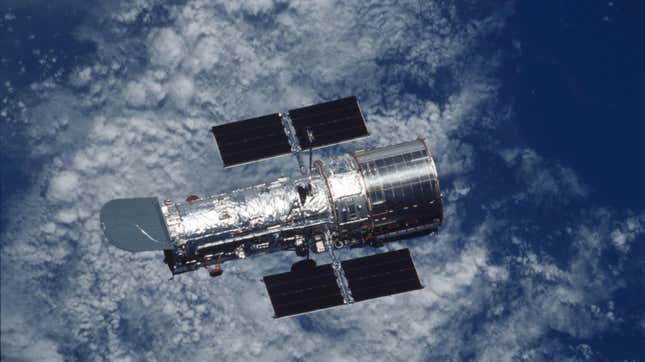
For more than 30 years, NASA’s iconic Hubble Space Telescope has been scouring the cosmos to look for ancient galaxies and dazzling nebulae. The wear and tear of traveling through low Earth orbit is starting to show on the aging telescope, forcing it to resort to using only one of its three remaining gyroscopes to determine its orientation.
NASA made the decision to transition Hubble to one-gyro mode after a series of issues with one of its three gyroscopes caused the telescope to repeatedly suspend its science operations, the space agency announced on Tuesday. “We believe this is our best approach to support Hubble’s science through this decade and into the next,” Mark Clampin, director of the astrophysics division at NASA, said during a press briefing. “One-gyro mode actually returns Hubble to consistent science operations and it allows us to keep another gyro working…for potential future use.”
Related Content
Gyroscopes are used to determine the direction in which the telescope is pointing and to maintain its orientation. Hubble started off with six gyros on board, but only three remain operational today. The telescope can operate with just one, but it uses all three for increased efficiency.
“Although Hubble can continue science operations in one-gyro mode, there are some limitations in comparison to our normal three-gyro settings,” Patrick Crouse, project manager of Hubble, said during the briefing. With one gyro, the telescope will take more time to move from one target attitude to the next and to be able to lock onto that new target, which will lead to lower efficiency, according to Crouse. In terms of how many science observations are scheduled throughout a single week, the team expects to see a 12% reduction in the number of observations (which is currently at 85 per week).
The ongoing issue with Hubble’s gyroscope has triggered the telescope to enter safe mode automatically four consecutive times. Most recently, Hubble entered safe mode on May 24 due to one of its three gyroscopes giving faulty telemetry readings. The telescope had only resumed operations on April 29, recovering from another glitchy episode. Earlier in November 2023, one of the gyros returned similar wacky readings, which prompted Hubble’s safe mode the first time. The telescope resumed operations the next day, only to enter safe mode once again.
Despite its downgraded status, NASA dismissed a proposal to raise Hubble to its initial altitude of 373 miles (600 km), allowing it to remain operational for a few more years. The proposal was put forth by billionaire astronaut Jared Isaacman, suggesting to launch a crew on board SpaceX’s Crew Dragon spacecraft. “We are not going to pursue a re-boost right now,” Clampin said. “Our assessment raised a number of considerations, including potential risks such as material losses, fires, and some technology challenges.”
“While the re-boost is an option for the future, we believe we need to do some additional work to determine whether the long term science return will outweigh the short term science,” he added.
For more spaceflight in your life, follow us on X and bookmark Gizmodo’s dedicated Spaceflight page.

